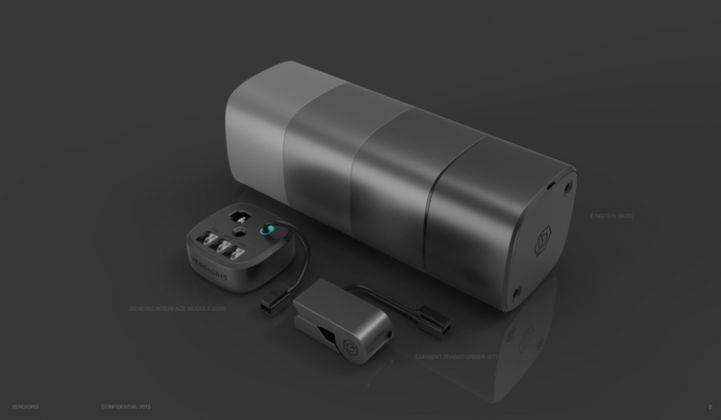"Energy disaggregation" is a broad term for technology that turns electrical circuits and meters into sensors, and uses the data collected to create fine-tuned maps of energy usage in buildings. The main difference between technologies is in the data -- the more of it, the more accurate and actionable the results.
Verdigris has taken the super-high-frequency route to disaggregation, with circuit-panel-installed sensors that collect thousands of data points per second, analyze them on the spot, and feed them to its cloud-based analytics engine. That allows Verdigris to map out energy use inside of a building on a system-by-system, appliance-by-appliance level, something that would otherwise require a lot of sensors to understand.
On Tuesday, the San Francisco-based startup announced it has raised $6.7 million in equity financing from at least one customer that likes what it’s seen so far. Contract manufacturing giant Jabil, which is in the process of scaling Verdigris’ technology across its sites, led the round, and was joined by new investor Verizon, which supplies the wireless connectivity for the startup’s sensors.
The new funding comes on top of $9 million raised from Jabil in March, and about $16 million in investment prior to that, CEO Mark Chung said. Verdigris has about 50 customers today, and more than a dozen of those have come on board in the past six months -- “We’re scaling up the installations quite a bit,” Chung said.
The new funding will go toward expanding its device manufacturing, software and customer service teams to meet these deliverables. Right now the startup has about 20 employees and works out of NASA’s Moffett Field site near San Jose, where it’s also involved in research into the data analysis capabilities of its technology, he said.
Energy disaggregation technologies are all different in complex ways, but they can generally be divided into two categories based on how much data they need to do their jobs. Low-frequency data, like 15-minute energy reads from smart meters, can be used to figure out key loads like HVAC or lighting with fairly high degrees of accuracy, around 80 percent or 90 percent. But they can’t capture more discrete loads as accurately, if at all.
High-frequency data energy disaggregation requires extra sensors, which makes it more expensive. But it can deliver much more accurate and granular results, because those sensors can catch the tiny blips and squiggles in voltage and current across a building’s key circuits in excruciating detail, and use that data to identify individual devices on the circuits, and then track them over time.
Chung said that Verdigris differentiates itself from many other disaggregation technologies out there in terms of the amount of data it’s collecting. “We’re at 8 kilohertz,” or 8,000 times per second, “which is a ton of information. Even at modern data transmission rates, that would eat up a ton of bandwidth." As a result, Chung said his company does a lot of "edge processing” using ARM-based processors in each sensor to filter and analyze the flood of real-time data.
A typical installation can be done in half an hour, and it can start collecting data shortly thereafter, he said. From there, it takes some time to “learn” the building’s device-specific electricity map, using its library of data on electrical signatures to automatically discover many of them, and working with customers to manually identify the rest.
Verdigris did some early work in residential energy disaggregation, alongside startups like Bidgely and Plotwatt, including a pilot with Pacific Gas & Electric. But the startup has shifted away from residential to providing services directly to commercial and industrial customers, which have more of an incentive to collect and analyze data about energy use.
The startup's customers include hotels owned by Hyatt, Intercontinental, Marriott and Starwood, which are using the platform to manage their peak energy consumption to reduce demand charges, said Chung. Verdigris integrates into building management systems from companies like Honeywell, Schneider Electric, Siemens and Johnson Controls, giving it the ability to actively control energy consumption based on its disaggregation analysis, he said.
At industrial sites like Jabil’s, the uses range from fine-tuning building energy management and measuring the carbon reduction effects of increased efficiency, to monitoring individual devices to predict failures and schedule maintenance, he said.
“Jabil is one of our biggest customers -- they use it globally,” he said. “We’re looking across their portfolio and analyzing anomalies. They do cookie-cutter factories around the world. We have the opportunity to see how geographic differences impact their portfolio.”
While these data-enabled asset health and protection capabilities are being built into equipment from companies like GE, Siemens and the like, upgrading a factory to these internet-of-things standards can be an expensive proposition, compared to putting some sensors at circuit panels.
There is no industry group or standards body in charge of testing and certifying the different energy disaggregation technologies out there, although the Electric Power Research Institute has been conducting tests aimed at informing that kind of work. “We do a lot of internal benchmarks on our algorithms to ensure we’re reporting results accurately,” Chung said.
But like most big-data applications, Verdigris will get more accurate and more useful the more data it gets, he added. “The amount of data our sensors have is a limited footprint. But what our neural network could do with a thousand buildings -- there’s great promise there.”



